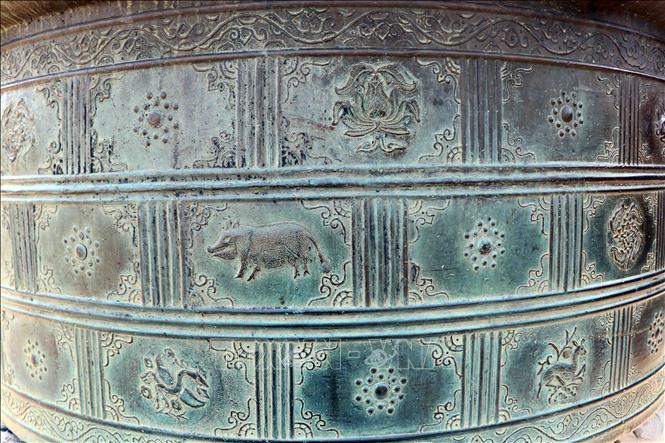All of these copper cauldrons are of substantial size and weigh from several hundred to a few thousand catties. At present, within the gardens of the Đại Nội area in Huế, there are seven large copper cauldrons cast during the 17th century under the Nguyen lords' rule over Đàng Trong. In terms of design, size, age, and artistic decorative style, these seven cauldrons can be divided into two groups.
1. Group of cauldrons cast during the Trịnh-Nguyễn conflict period:
This group consists of three cauldrons: one in front of the Kiến Trung Palace, cast in the seventh year of Thịnh Đức (1659); one in front of the Tả Vu House, cast in the eighth year of Thịnh Đức (1660); and one in front of the Hữu Vu House, cast in the tenth year of Thịnh Đức (1662). These cauldrons all have an upright body, wide flared mouth, and raised handles, with four handles attached to the rim. The decorative arrangement features horizontal bands encircling the cauldron. From the top downward, there are nine bands separated by raised ridges. Bands 3, 4, 6, and 7 are narrower, while bands 1, 9, 2, 5, and 8 are wider, adorned with continuous undulating vine motifs forming a closed loop. The wider bands 2, 5, and 8 are the main decorative elements, divided into equal-sized rectangular compartments by vertical straight lines, each compartment showcasing unique floral patterns. The floral decoration forms a complete circle on the band 5 of the cauldron in front of the Kiến Trung Palace. These three cauldrons are nearly equal in weight and size. The cauldron in front of the Tả Vu House is slightly larger, weighing 2582 catties (Vietnamese measurement); it has a mouth diameter of 2.2m, an interior diameter of 1.83m, and a height of 1.05m (including the 1.30m-high handles). The decorative style of enclosed horizontal bands was popularized in Đông Sơn culture, featuring wave-like vine motifs that create a dynamic rhythm.
The decorative motifs include flowers, leaves, birds, and animals. The cauldron cast in 1695 features only flowers and leaves, while the two cauldrons cast in 1660 and 1662 also include birds and animals. The birds and animals on the cauldron from 1660 move counterclockwise, but on the cauldron from 1662, there's a depiction of a creature moving in the opposite direction.
2. Group of cauldrons cast towards the end and after the Trịnh-Nguyễn conflict:
This group consists of four cauldrons, including three dating back to the Cảnh Trị era and one to the Chính Hòa era. The cauldron cast in 1670 is only 8 years after the late cauldron from the previous group, but its design, arrangement, size, and decorative motifs are entirely different, indicating a new direction in development. The two cauldrons cast in 1762, one located on the left side of the Thái Hòa Palace and the other on the right side of the Càn Thành Palace, as well as the cauldron cast in 1684, also on the Càn Thành Palace but on the left side, are the remaining pieces from this group.

Patterns and motifs on the cauldron at the same time Lord Nguyen placed in the Citadel - Hue
This group of four cauldrons varies slightly in size, but their design is entirely uniform. The largest cauldron in this group, located at the Càn Thành Palace, weighs 1390 catties